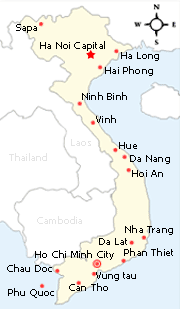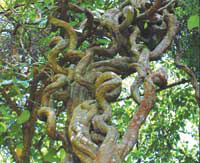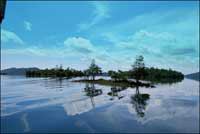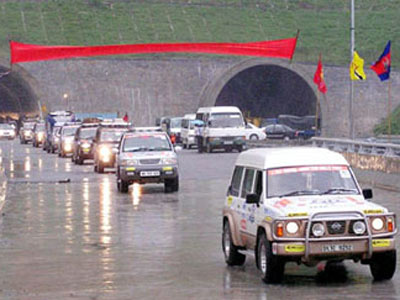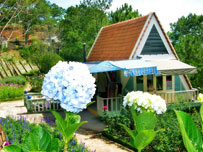Vietnam Open Tour News & EventsLake of pleasant dreams The central province of Quang Nam is full of charm. It boasts the ancient town of Hoi An, the My Son Tower, which is a remnant of the Champa kingdom, and the vast Phu Ninh Lake.
Who’s counting: Phu Ninh Lake is a natural home to more than 142 plant species and 148 kinds of animals. The lake covers a total of more than 23,000ha, which is dotted with about 30 idyllic islands. The area is home to more than 142 plant species and 148 kinds of animals, including 14 listed in the Viet Nam Red Book of threatened species. Phu Ninh is the name of a small village on the Que River. In 1927, the French colonial government had plans to dam the river and create a lake. But nothing happened until 1977 when construction finally began after a strong push by Quang Nam residents backed by national experts. For 11 years until 1986, tens of millions of tonnes of soil and stones were moved into place to dam the Que River and create the lake. The dam, the biggest in the central region and the second biggest in the nation, is a major tourist attraction. To tap into the tourism potential of Phu Ninh, the local government has created a development plan in consultation with the French As Conis Group and sponsorship from the French province of Nors Pas de Clais. Nearly 700ha out of the total 23,000ha Phu Ninh Lake area is included in the plan. So, in the future, tourists will have access to eight different areas, including the Tu Yen Tourist Centre, a mountain resort, mineral bathing resort, accommodation, residential complex, eco tourism and camping.
Time for reflection: The first impression when visitors arrive in Phu Ninh is the vast lake, blue skies, mountains, islands and pure air. The people in the region are friendly and live close to nature. Phu Ninh is a place to visit for those wishing to get away from noisy, crowded and polluted cities. The first impression when visitors arrive in Phu Ninh is the vast lake, blue skies, mountains, islands and pure air. Even when the sun is shining, the weather is usually cool. From the entrance gate to the tourism area is about 5km. The Tu Yen centre has comfortable hotels and restaurants, an eco tourist boat fleet and places for fishing and camping. Visitors can visit Black Stone Hill, examine the model of the whole ecological area and visit small islands. One island is known as Rua because it resembles a swimming turtle, another is called Sixty One Island because it is 61m above sea level. Su Island is named after its rubber trees and Khi Island is full of monkeys. The day begins in Phu Ninh with the songs of birds echoing through the forests - tiem to wake up and breathe in the freshest air imaginable and go for a swim in clear, blue water. As the sunlight spreads across the surface of the lake, visitors can catch a boat to visit the great dam wall blocking the river. Old temples and pagodas lie at the base of mountains stretching as far as the eye can see. They are often wreathed in mist and light swirls of smoke wafting up from kitchen fires in a village at the base of one of the mountains. For those interested in fishing, small boats are available for those who wish to go it alone. It is not difficult to manoeuvre one of the small vessels. Many say there is nowhere where it easier to catch fish than in Phu Ninh. Fish seem to lie in wait for a baited hook. Some tourists light little fires to barbecue their catch - others get restaurants to do it for them. When night arrives, tourists often gather around camp fires on one of the islands singing merrily as the moon and stars shine overhead. The sounds of light breezes in the leaves and waves lapping on the shore eventually put everyone to sleep. VietNamNet/Viet Nam News Right-handed cars must have guides The Ministry of Transportation’s draft decree on managing right-handed cars used by foreigners in Vietnam requires these cars to run in groups, with guides.
Cars with right-handed steering wheels entered Vietnam via a border-gate in the central region. The ministry said that drivers of this type of car will face difficulties in Vietnam because of the country’s contrary traffic system so they need to have guiding cars. Tran Ngoc Thanh, chief of the Transportation Department, said that the guide will be arranged by travel agents that organize trips for right-handed cars to Vietnam. “All guiding cars must obey the traffic rules and are not allowed to enjoy the priority policy,” Thanh said. To avoid the flow of cars with right-handed steering wheels into Vietnam, the drivers must be foreigners. Moreover, these cars must transport men, not cargo, Thanh said, explaining that this decree aims to promote tourism in Vietnam. Thanh also said that the agreement that facilitates goods and visitors passing the borders of the member countries of the Great Mekong Sub-region (GMS) (Laos, Thailand, Vietnam) is being revised so that right-handed cars that transport cargos must obey this agreement. “Right-handed cars that transport cargos must travel on certain routes like Lao Cai – Hai Phong, the route in the central region, Kim Giang and some others. These roads have systems of bilingual road signs and traffic networks that are suitable for this kind of car,” Thanh added. This decree was introduced to related ministries and agencies for consideration and comment on April 7 and submitted to the Prime Minister recently. VietNamNet/VNE Da Lat’s bushels of blossoms
Minh Tam Flower Garden, a famous venue in the resort town of Da Lat Nestled 1,500 meters above sea level on the Langbiang Plateau in the southern area of Vietnam’s Central Highlands, the picturesque landscapes of Lam Dong Province’s Da Lat Town attract large numbers of tourists annually. Thanks to its fresh, cool air, majestic waterfalls and thousands of brilliant flowers, the community is a favorite destination for both Vietnamese and foreign visitors alike. The name Da Lat originates from the ancient hill tribe people who once populated the region and means “stream of the Lat people.” Arriving in Da Lat, situated 320 kilometers from Ho Chi Minh City, tourists are always astonished at the town’s overflowing bounty of flowers. Blossoms can be seen everywhere in countless varieties including orchids, mimosas, pansies, wild sunflowers and roses. There are also many rare types of flowers found in few other places in the country. The easiest to spot are the orchids, dubbed locally as “queen of the flowers.” Of the world’s 100,000 species of orchids, as many as 500 types are grown in the town. Da Lat also boasts a unique species of orchid called lan hai, which received much attention and praise when it was displayed at an orchid exhibition in Tokyo, Japan a few years ago. The flower was named for its resemblance to a type of embroidered shoe worn by noble women, known in Vietnamese as “hai.” The tree, which originates from Australia, comes into bloom three times a year during the dry season. Da Lat is home to two types of mimosa trees, one is a long-leafed variety and the other is short-leafed. Local songwriter Tran Kiet Tuong found great inspiration in the mimosa and wrote a song based on the tree’s beauty. According to folklore, Da Lat girls would often place mimosa flowers between the pages of a book, and then send it to their boyfriends. The pressed flowers would retain their sweet scent, and act as a fond reminder of the girls. Like the mimosa itself, this practice is said to have stemmed from Australia. Among thousands of varieties of flowers, the Da Lat rose is a particular favorite nationwide. Aside from being sold in the town’s markets, roses are also transported to larger markets in other provinces and cities, including Hanoi and HCMC. The flowers come in all sort of colors and shades including pink, violet and yellow. The yellow roses are known locally as “Josephine,” after the wife of Napoleon Bonaparte, while other roses are also referred to after famous movie stars and nobility. Watercolor waterfalls and more The town of Da Lat is also well known for its breathtaking waterfalls, including the Prenn, Cam Ly, Dambri and Pongua. Prenn Waterfall, located at the foot of Prenn Pass and about 10 km from the center of Da Lat, is considered a symbol of the town. Behind the cascading water is a bamboo bridge where visitors can cross through a spray of refreshing mist. Tourists can also explore the surrounding area, home to a wide variety of animals. Locals compare the scenery at Prenn Waterfall to that of a watercolor painting. The water pouring over the top of the fall creates a sheet of silver, which flows into a swirling pool of white foam at the bottom. A nearby photo shop allows visitors to have their photo taken at the falls to commemorate their trip. Tourists can also take a horse or elephant ride while touring the area, or rent a canoe to discover the waterfall’s surrounding canals. Nearby Xuan Huong Lake, spanning five square kilometers, is another picturesque area and popular with honeymooners. This manmade lake, which was named after famous Vietnamese poet Ho Xuan Huong who lived in the 18th-century, was also a site where many indigenous people of Highland Langbian ancestry made their homes. In 1984, scientists found many ancient relics at the bottom of the lake belonging to the hill tribes that once lived in this area. Another well-known Da Lat lake is Tuyen Lam, located five kilometers south of the town. Tuyen Lam is known as the lake where rivers, springs and forests converge. The immense area stretches over 350 hectares from the beautiful Tia Spring and Da Tam River to Voi Mountain. Da Lat is also known for its Valley of Love, known in Vietnamese as Thung lung tinh yeu. Situated about five kilometers outside of town and spanning about 242 hectares, the Valley of Love is filled with scenic, rolling pine tree-clad hills, perfect for picnics. For those who love to hike, the 1,900-meter tall Lang Biang Mountain takes around three hours to climb. For others who would rather drive up, jeeps can be hired for around US$10. Other tourist attractions in Da Lat Town include the Da Lat Market, Lake of Sighs, and the summer Palace of Bao Dai, the last king of Vietnam. According to Sato Kohara, a Japanese fine arts student touring the area, “I have visited many sites in Vietnam, but still felt surprised when I arrived here. This site is peaceful, romantic and fresh. “If I have a chance to visit Vietnam again, I will return to this site together with my friends,” she adds. VietNamNet/Thanh NienNews for Sunday 23 August, 2009
View all news for Sunday 23 August, 2009 on one page Recent News
|

